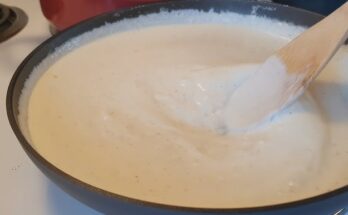Almond Nut Cake Recipe: If you’re craving a cozy, nutty, and slightly sweet dessert that makes your kitchen smell like heaven, then this almond nut cake recipe is exactly what you need. It’s soft, rich, buttery, and generously packed with crunchy almonds that give it an irresistible texture and flavor.
Whether you’re a seasoned baker or just starting out, this guide will walk you through everything—from the ingredients to baking techniques and expert tips. So roll up your sleeves, preheat that oven, and let’s make some magic in your kitchen.
Why You’ll Love This Almond Nut Cake
There’s something about almonds that gives a dessert an old-fashioned charm. Maybe it’s the slightly sweet, earthy flavor or the delightful crunch they add. Either way, this almond nut cake is a crowd-pleaser. It’s one of those cakes that doesn’t try too hard—simple ingredients, straightforward method, and no complicated decorations—yet it tastes like something from a fancy bakery. You’ll love it for breakfast with coffee, as a mid-day snack, or dressed up for dessert. It’s versatile, it freezes beautifully, and it’s always a hit at potlucks or family gatherings.
This recipe uses both chopped and ground almonds to double down on flavor and texture. The result? A moist, tender crumb with nutty surprises in every bite. And don’t even get me started on the almond glaze—it takes this cake from great to unforgettable.
The Perfect Occasions to Serve Almond Nut Cake
This cake is like your favorite cozy sweater—perfect for almost any occasion. Hosting a tea party? Almond nut cake. Need a dessert for a birthday, potluck, or brunch? Almond nut cake. Want a comforting treat after a long day? You guessed it—almond nut cake.
It’s not overly sweet, which makes it ideal for pairing with fruit, whipped cream, or a scoop of vanilla ice cream. You can even turn it into a layered celebration cake or bake it in a loaf pan for easy slicing. Birthdays, holidays, rainy days—this cake has your back.
List of Ingredients You’ll Need
Let’s break down the ingredients so you’re fully prepared before you start baking. This recipe uses pantry staples plus a few stars to bring out that deep almond flavor.
Dry Ingredients
- 1 ¾ cups all-purpose flour
- ½ cup almond flour (for that rich, nutty flavor)
- 1 tsp baking powder
- ½ tsp baking soda
- ¼ tsp salt
Wet Ingredients
- 1 cup (2 sticks) unsalted butter, softened
- 1 cup granulated sugar
- 4 large eggs, room temperature
- 1 tsp vanilla extract
- 1 tsp almond extract
- ½ cup whole milk or buttermilk
Optional Add-ins
- ¾ cup chopped toasted almonds
- ½ cup sliced almonds (for topping)
- Zest of one lemon (for brightness)
- ½ tsp cinnamon (for warmth)
These ingredients work together to create a tender crumb, rich flavor, and perfect balance of sweet and nutty. Don’t skip the almond extract—it’s essential for that signature almond flavor.
Kitchen Tools and Equipment You’ll Need
Before we jump into mixing and baking, make sure you’ve got the right tools on hand:
- Stand mixer or hand mixer
- Mixing bowls
- Measuring cups and spoons
- 9-inch round or square cake pan
- Rubber spatula
- Wire rack for cooling
- Toothpick or cake tester
- Sifter (for dry ingredients)
- Small saucepan (if making the glaze)
Having your tools ready makes the process smoother and more enjoyable. Baking is part science, part art—but mostly, it’s about being prepared.
Tips Before You Start Baking
Want to bake like a pro? Here are a few golden rules:
- Room temperature ingredients: This helps everything blend more evenly. Take your eggs, butter, and milk out of the fridge 30 minutes before starting.
- Toast your almonds: It enhances their flavor and gives your cake a beautiful crunch.
- Don’t overmix: Once you add the flour, mix just until combined to keep the cake tender.
- Prep your pan: Grease and line your cake pan with parchment paper to prevent sticking.
- Use fresh ingredients: Especially your baking powder and soda—check their expiration dates.
Step-by-Step Guide to Making Almond Nut Cake
Let’s get baking! Follow these detailed steps for a perfect almond nut cake every time.
Step 1: Preheat the Oven and Prep Your Pan
Set your oven to 350°F (175°C). Lightly grease a 9-inch cake pan and line the bottom with parchment paper. This step might feel simple, but it sets the tone for success—no sticking, no uneven baking.
Step 2: Toast the Almonds (Optional But Recommended)
Spread chopped and sliced almonds on a baking sheet and toast in the oven for 5–7 minutes. Let them cool before adding them to the batter. Toasting brings out a deep, rich flavor that makes the cake truly stand out.
Step 3: Sift and Mix Dry Ingredients
In a medium bowl, sift together:
- All-purpose flour
- Almond flour
- Baking powder
- Baking soda
- Salt
Sifting helps lighten the flour and ensures everything is evenly mixed. Set aside.
Step 4: Cream the Butter and Sugar
In a large bowl, cream the softened butter and sugar using a stand or hand mixer. Beat until light and fluffy—this can take about 3–5 minutes. This step adds air into the batter, giving your cake that soft, tender texture.
Step 5: Add Eggs One at a Time
Crack in the eggs, one at a time, mixing well after each addition. Scrape down the sides of the bowl as needed. This step helps the batter emulsify and creates a smooth base.
Step 6: Add Dry Ingredients Alternating with Milk
With the mixer on low, add the dry ingredients in three parts, alternating with milk. Start and end with the dry mixture. Add vanilla and almond extract during this stage. Don’t overmix—just blend until incorporated.
Step 7: Fold in Almonds and Other Add-ins
Using a rubber spatula, gently fold in the toasted chopped almonds, lemon zest, and cinnamon if using. Folding ensures the almonds stay whole and the batter remains airy.
Step 8: Pour the Batter and Bake
Pour the batter into your prepared pan and smooth the top with a spatula. Sprinkle sliced almonds on top for a beautiful, crunchy finish. Bake in the preheated oven for 35–45 minutes.
Step 9: Test for Doneness
Once the cake has been in the oven for about 35 minutes, start checking for doneness. Insert a toothpick or cake tester into the center of the cake—if it comes out clean or with just a few moist crumbs, your cake is ready. If it comes out with wet batter, give it another 5 to 10 minutes and test again. Every oven is different, so don’t be afraid to keep an eye on it toward the end.
You’re looking for a golden brown top, slightly puffed center, and a firm texture when lightly pressed. And don’t worry if it has a few cracks—those are just signs of homemade goodness.
Step 10: Cool and Release from the Pan
Once your cake is fully baked, take it out of the oven and place it on a wire rack. Let it cool in the pan for about 15 minutes. Then, run a knife along the edges to loosen it and gently turn the cake out onto the rack to cool completely.
Why is this important? If you try to take the cake out too soon, it might break apart. On the flip side, leaving it in the pan too long can cause it to become soggy on the bottom due to steam.
Once completely cooled, you’re ready to glaze, decorate, or dive right in!
How to Make a Simple Almond Glaze (Optional)
Want to take this almond nut cake to the next level? Whip up this super easy almond glaze. It adds moisture, sweetness, and that extra almond punch everyone loves.
Ingredients:
- 1 cup powdered sugar
- 2–3 tablespoons milk or cream
- ½ teaspoon almond extract
Instructions:
- In a small bowl, whisk together the powdered sugar and almond extract.
- Slowly add milk, one tablespoon at a time, until the glaze is smooth and pourable but not too runny.
- Drizzle it over the cooled cake using a spoon or pour it from a small jug.
- Let it set for 10–15 minutes before slicing.
You can also add a pinch of salt or some lemon zest to the glaze if you like a bit of complexity. The sweetness of the glaze pairs beautifully with the nuttiness of the cake.
Decorating and Serving Suggestions
This cake is naturally beautiful with its golden-brown top and toasted almond topping, but if you want to get fancy, here are a few ideas:
- Dust with powdered sugar for a rustic, snowy look.
- Top with whipped cream and fresh berries for a bright, fresh flavor.
- Serve with a scoop of vanilla ice cream and a drizzle of honey or caramel.
- Add edible flowers or mint leaves for a pop of color.
Presentation counts—especially when you’re serving this cake at a party or event. A simple cake stand, some sliced almonds scattered around the base, and a drizzle of glaze can make it look bakery-worthy with minimal effort.
Storage and Shelf Life Tips
You’ve baked a beautiful almond nut cake—now how do you store it?
- Room Temperature: Store in an airtight container for up to 3 days. Make sure it’s completely cooled before sealing to avoid condensation.
- Refrigerator: If you used glaze or frosting, refrigerate for up to 5 days. Let it come to room temp before serving for the best texture.
- Cover well: Use plastic wrap, foil, or a cake dome to prevent it from drying out.
This cake stays moist for days, and the flavor deepens over time. Many people say it tastes even better the next day!
Can You Freeze Almond Nut Cake?
Absolutely! This cake freezes beautifully, making it perfect for make-ahead desserts or meal planning.
To Freeze:
- Let the cake cool completely.
- Wrap it tightly in plastic wrap, then in foil.
- Label and date it, then place it in the freezer.
It’ll keep well for up to 3 months. When you’re ready to enjoy it:
- Thaw in the refrigerator overnight or at room temp for a few hours.
- Reheat individual slices in the microwave for 15–20 seconds for that just-baked feel.
Pro tip: If you plan to glaze the cake, do it after thawing for the freshest presentation.
Common Mistakes to Avoid
Even the simplest cakes can go wrong without the right approach. Here are a few common mistakes to watch out for:
- Using cold ingredients: Always use room temperature butter, eggs, and milk for a smooth batter.
- Overmixing the batter: This can make your cake tough and dense.
- Skipping the almond extract: It’s essential for that deep almond flavor.
- Under-toasting the almonds: Raw almonds lack that signature flavor and crunch.
- Not testing for doneness: Every oven is different—always test with a toothpick before pulling the cake out.
Avoid these pitfalls, and your cake will come out perfect every time.
Almond Nut Cake Variations
Looking to mix things up? Try one of these delicious twists:
- Chocolate Almond Cake: Add ½ cup cocoa powder and chocolate chips.
- Lemon Almond Cake: Add lemon juice and zest to the batter and glaze.
- Coconut Almond Cake: Swap ¼ cup of flour for shredded coconut and add coconut extract.
- Gluten-Free Almond Cake: Use a 1:1 gluten-free flour blend and almond flour.
- Vegan Almond Cake: Use vegan butter, flax eggs, and almond milk.
These variations let you customize the recipe for dietary needs or just a change of flavor. Almond is a wonderfully versatile base that pairs well with so many ingredients.
Health Benefits of Almonds
Not only are almonds delicious, but they’re also packed with nutrients. Here are a few reasons to love them:
- Rich in Vitamin E: Great for your skin and immune system.
- High in fiber: Supports digestion and keeps you full.
- Heart-healthy fats: Can help reduce bad cholesterol.
- Protein-packed: Perfect for energy and muscle repair.
- Loaded with antioxidants: Especially concentrated in the almond skin.
Adding almonds to your cake isn’t just about taste—it’s a sneaky way to make dessert a little healthier too!
FAQs about Almond Nut Cake Recipe
1. What makes almond cake moist?
The combination of butter, milk, and almond flour gives this cake its rich, moist texture. Almond flour in particular holds moisture well, preventing the cake from drying out.
2. Can I use almond flour instead of all-purpose flour?
Yes, but not entirely. Almond flour doesn’t contain gluten, which helps hold cakes together. You can replace a portion (up to 50%) of the all-purpose flour with almond flour for a moist, nutty flavor without compromising structure.
3. How long does almond nut cake stay fresh?
Stored in an airtight container, the cake will stay fresh at room temperature for 3 days or in the fridge for up to 5 days. It can also be frozen for up to 3 months.
4. What’s the best way to toast almonds?
Spread them on a baking sheet and toast in a 350°F oven for 5–7 minutes. Keep an eye on them—they can burn quickly. Let them cool completely before adding to the batter.
5. Can I make it gluten-free?
Absolutely. Use a 1:1 gluten-free flour mix in place of the all-purpose flour and ensure your almond flour is certified gluten-free.
Conclusion
There you have it—a step-by-step guide to baking the perfect almond nut cake. Whether you’re making it for a celebration or just treating yourself to a slice of homemade comfort, this cake is sure to hit the spot. It’s buttery, moist, and bursting with nutty goodness in every bite.
Don’t let the simplicity fool you—this cake is elegant enough for special occasions and easy enough for everyday baking. With the right ingredients, a little patience, and this guide by your side, you’ll have a beautiful almond nut cake ready to impress your family, friends, or even just yourself.
So, what are you waiting for? Go preheat that oven and get baking!



